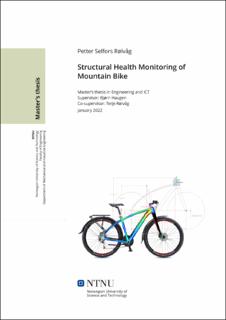| dc.contributor.advisor | Haugen, Bjørn | |
| dc.contributor.advisor | Rølvåg, Terje | |
| dc.contributor.author | Rølvåg, Petter Selfors | |
| dc.date.accessioned | 2022-05-12T17:20:01Z | |
| dc.date.available | 2022-05-12T17:20:01Z | |
| dc.date.issued | 2022 | |
| dc.identifier | no.ntnu:inspera:97512984:37071451 | |
| dc.identifier.uri | https://hdl.handle.net/11250/2995511 | |
| dc.description.abstract | En tilnærming for implementering av en sanntids digital-tvilling (DT) basert strukturell helse overvåking (SHO) av sykkelrammer presenteres i denne oppgaven. Det primære målet er å etablere et IT-system som kan støtte SHO via bruk av tingenes internetteknologi, samt å anvende og utvikle DT-metodologier. Når server- og klientløsningene ble utviklet, benyttet forfatteren seg av Mendix, en plattform-som-en-tjeneste-løsning, som det primære utviklingsverktøyet. Forfatterne brukte en Arduino til å digitalisere de virkelige belastningene, akselerasjonene og belastningstidshistoriene som sykkelen opplever. Smarttelefonen er koblet til en Arduino via Bluetooth, og dataene fra sensorene blir anvendt før de lastes opp til skyen. På grunn av det faktum at DT tilnærminger er skybaserte og bruker sensordata, hjelper de til med å utvikle et såkalt tingenes internett økosystem med andre enheter som smarttelefonen og Arduino, ettersom som alle produserer og konsumerer data fra den samme databasen. Den digitale tvillingen er representert av en 6x8 oppslagstabell, som tillater sanntidsberegning i 8 virtuelle strekklapper som skal utføres under en sykkeltur. 6x8 oppslagstabellen er forhåndskomponert ved hjelp av en enhetslastmetode brukt på en sykkelramme modellert i et element metode programvare. Med utgangspunkt i en enkelt IMU-sensor, ble en analytisk invers metode for bestemmelse av dynamiske sykkelbelastninger bygget. Hver kolonne i ROM representerer stressfordelingen i 8 målere forårsaket av enhetsbelastningen. De virkelige målespenningene beregnes ved å multiplisere 6x8-matrisen med de 6 belastningene beregnet etter invers metoden. Støyreduksjon og singularitetsfjerning utføres på sensormålingene. For modellkalibrering og validering ble ytterligere strekkmålere og midlertidige akselerometre satt på sykkelen. Den nåværende teknikken er generisk, men lineær og kan derfor bare brukes på udempede sykkelrammer. Funnene innebærer at det er potensiale for forbedring i både tingenes internett systemet og de anvendte DT metodene. Listen over mulige forbedringer er omfattende og fremtidige muligheter skaper nysgjerrighet. | |
| dc.description.abstract | An approach for the implementation of real time digital twin (DT) based structural health monitoring (SHM) of bicycle frames is presented in this thesis. The primary goal is to establish an Informational Technology (IT) system that can support SHM via the use of Internet of Things (IoT) technology, as well as to apply and develop DT methodologies. When developing the server and client solutions, the authors utilized Mendix, a platformas-a-service solution, as the primary development tool. The authors used an Arduino to digitize the real loads, accelerations, and strain time histories that the bicycle is experiencing. The smart phone is connected to the Arduino through Bluetooth, and the data from the sensors is consumed before being uploaded to the cloud. Due to the fact that the DT approaches are cloud-based and consume sensor data, they help to develop an Internet of Things ecosystem with other devices such as the smart phone and Arduino, which all produce and consume data from the same database. The digital twin is represented by a 6x8 look-up table, which allows real-time strain calculations in 8 virtual strain gauges to be performed during a bicycle ride. The 6x8 look-up table is precomputed using a unit-load approach applied to a bicycle frame modelled in a Finite Element (FE) software. On the basis of a single IMU sensor, an analytical inverse method for the determination of dynamic bicycle loads is built. Each column in the ROM represents the stress distribution
in 8 gauges caused by one unit load. The real gauge stresses are calculated by multiplying the 6x8 matrix with the 6 loads calculated by the inverse method. Noise reduction and singularity removal are performed on the sensor outputs. For model calibration and validation, additional strain gauges and temporary accelerometers were put to the bicycle. The current technique is generic but linear and hence only applicable to undamped bicycle frames. The findings imply that there is potential for improvement in both the IoT system and inverse method. The list of possible enhancements is extensive, and the future possibilities are intriguing. | |
| dc.language | eng | |
| dc.publisher | NTNU | |
| dc.title | Strukturovervåkning av Terrengsykkel | |
| dc.type | Master thesis | |
